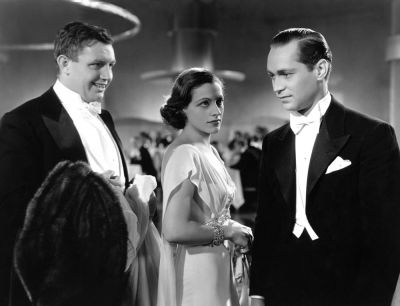
MIDNIGHT MARY
(USA/1933) R.: William Wellman. D.: 74'. V. inglese
Sog.: Anita Loos. Scen.: Gene Markey, Kathryn Scola. F.: James Van Trees. M.: William S. Gray. Scgf.: Stan Rogers. Mus.: William Axt. Int.: Loretta Young (Mary), Ricardo Cortez (Leo), Franchot Tone (Tom), Andy Devine (Sam), Una Merkel (Bunny), Charles Grapewin (Clerk), Frank Conroy (procuratore distrettuale). Prod.: Lucien Hubbard per Metro-Goldwyn-Mayer Corp.
35mm . D .: 74' . Versione inglese / English version
Da: Filmoteca Eşpañola
Cinquantacinque anni prima che John Carpenter fornisca al Roddy Piper di Essi vivono un paio di occhiali neri che permettono di vedere i messaggi subliminali disseminati nella società, Wellman conferisce gli stessi poteri alla protagonista di Midnight Mary, interpretata da Loretta Young. A lei però bastano due splendidi occhi per capire quello che strillano in realtà le insegne di Broadway: "non c'è lavoro", il tombale bollettino dell'epoca. È una delle sequenze più suggestive del film (e del cinema) e il suo momento più pregnante, per il messaggio ma soprattutto per gli occhi di Loretta Young. Quegli occhi dominano il film: spuntano sopra la copertina di un rotocalco e da sotto il banco di un giudice, brillano dietro le sbarre della prigione e dicono sempre la verità, anche quando il corpo è costretto a mentire per sopravvivere. Midnight Mary si apre con una scena tipicamente wellmaniana e mostra Mary in tribunale, processata per omicidio. Seduta in cancelleria ad attendere il verdetto, la giovane ripensa agli eventi che l'hanno portata fin qui. La struttura narrativa basata sul flashback, il cui tono e ritmo fanno pensare a Je t'aime, je t'aime di Resnais, trascina lo spettatore nel passato di Mary. La sua storia si snoda sullo schermo, e lo scorrere avanti e indietro delle immagini sottolinea l'impossibilità di un riscatto. A proposito delle donne ritratte da Wellman prima che entrasse in vigore il codice Hays, Michael Henry Wilson ha scritto: "L'eroina è raramente oggetto di corteggiamento romantico. Ben più spesso è vittima della lussuria, del voyeurismo e dei brutali approcci maschili". Questo aspetto può essere più esplicito in film quali Safe in Hell (1931) e Dangerous Paradise (1930), ma le situazioni in cui si trova Mary non sono diverse: la sua sopravvivenza è definita unicamente dai desideri degli uomini. Tra questi uomini ci sono anche i membri della giuria chiamati a decidere la sua sorte, nonché il Tom interpretato da Franchot Tone e il suo adorabile compare (Andy Devine, il quale collaborerà con Wellman in altri sette film), che pur essendo gentili e intenzionati a offrirle un lavoro onesto sono comunque guidati da impulsi di natura sessuale. L'eloquente primo flash-back ci mostra Mary bambina mentre stringe a sé una statuetta rotta trovata in una discarica e apprende della prematura morte della madre. La vita (e il film) per lei continua, ma non supererà mai veramente quel momento, quell'immagine, la macchina da presa (la linea dello sguardo di due poliziotti) che scruta una Mary cenciosa e terrorizzata, in un'infinita distesa di ciarpame.
Gina Telaroli
Fifty-five years before John Carpenter would give Roddy Piper's Nada a pair of truth-seeing sunglasses that allowed him to detect the real messages being displayed throughout society in They Live, Well-man would give Loretta Young's Mary the same perceptive powers in Midnight Mary, though she would only need her luminous eyes to learn that the billboards of Broadway actually advertise society's supreme bulletin: there aren't any jobs. Its one of the movie's (and cinema's in general) most haunting sequences, as well as its defining moment, for the message of course, but more importantly for Young's eyes, which dominate the film, peering over magazine covers and desks, shining in prison cells, and always telling the truth, even as her body is forced to lie in the name of survival. Midnight Mary opens with a typically Wellmanian framing device and finds Mary in court and on trial for murder. As she sits in the clerk's office (a scene with a quietly powerful turn by Charley Grapewin) and awaits her sentence, she reflects on what brought her there. A flash-back structure reminiscent in pacing and tone of Resnais's Je t'aime, je t'aime emerges and thrusts the audience into her history. Her past sashays across the screen, the back and forth movement of the frames highlighting her character's stagnant station in life. In writing about Wellman's pre-code women, Michael Henry Wilson said, "The heroine is rarely the object of romantic courting. Most often, she is subject to lust, voyeurism, and the brutal advances of men". This may be more openly apparent in films like Safe in Hell (1931) and Dangerous Paradise (1930), but Mary's various situations are no different, her survival being defined purely by the desires of men. Here those men range from those in the jury box who will determine her fate, to Franchot Tone's Tom and his lovable sidekick (Andy Devine, in his first of eight collaborations with Wellman), who may be kind and offer her honest work but who are nonetheless motivated by impulses of a sexual nature. The telling first look at Mary's past shows her as a child, hugging a discarded statue found in a junkyard as she hears about her mother's untimely death. Life (and thus the movie) goes on for Mary but she never really moves beyond that moment, that image, the camera (the eyeline of two police officers) peering over Young's dolled down and terrified Mary, caught in a pile of unending garbage.
Gina Telaroli

Tariffe:
Aria condizionata
Info: 051224605











